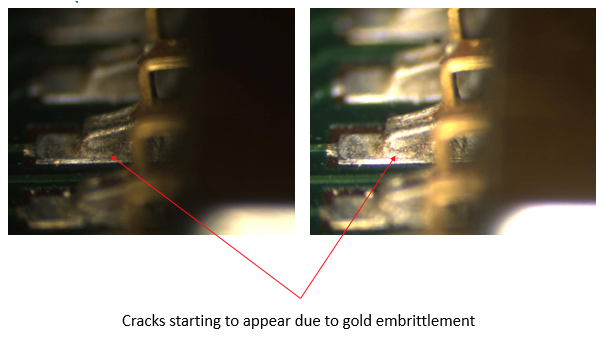- Home
- Who We Are
- What We Do
- Industry Applications
- Circular Economy
- Media
- Information Packs
- Interesting Reads
- What is Robotic Solder Dip (Retinning, Alloy Conversion, Alloy Refresh)?
- Reballing: What Is It And When Do You Need It?
- The Quiet Deadline: How Obsolescence Shapes Modern Production
- Safeguarding the Supply Chain: How Retronix Component Services Provides Solutions for High-Reliability Industries
- Is Your Supply Chain Safe? Combatting the Threat of Counterfeit Electronic Components
- Quality
- Contact
WHAT IS GOLD EMBRITTLEMENT?
Gold has been a popular material in the electronics industry for many years due to the corrosion protection that it offers. Many electronic components, such as connectors, pins, and some integrated circuit (IC) leads, are coated with a thin layer of gold. This gold plating serves two main purposes: it provides excellent corrosion resistance and ensures a long shelf life.
However, gold is very soluble in tin-lead and lead-free solders. During the soldering process, the gold dissolves into the molten solder. If the gold concentration in the solder joint exceeds about 3% by weight, it can form brittle intermetallic compounds, specifically gold-tin intermetallics. These compounds are very hard and can create stress concentrations within the joint.
The Consequences
A gold-embrittled solder joint is much weaker than a normal one. It is susceptible to cracking under thermal cycling (repeated heating and cooling) or mechanical stress (vibration or shock). This can lead to an intermittent connection or a complete open circuit. The failure is often not immediate; it can occur over time as the device is used, making it difficult to troubleshoot. This is a significant reliability concern in high-stakes applications, such as aerospace, medical devices, and military electronics.
With the almost total market domination of Electroless Nickel Immersion Gold (ENIG) finish on PCB’s, the risk of soldering a gold component to a pad is great. This in itself can make even the smallest of contributions to the gold percentage running a real risk of brittleness caused by gold dendrite growth. Historically, research into gold embrittlement has referenced the specific thickness of the gold plating. However, it is now proven that gold that dendrites inside solder joints can form no matter the thickness of gold.

Military, aerospace, and harsh environment applications, as well as some industrial standards, specify that gold plating must be removed from devices prior to soldering them to the PCB. Such measures inhibit the formation of gold inter-metallic issues, escaping the risk of fractures forming in the solder joint as a result.
What is the solution?
Many factors play a part in the risk of Gold Embrittlement including gold thickness, solder type, solder quantity, ramp rate, dwell times and gold layer condition.
The Retronix solution is to remove the gold from the termination, using our in house alloy conversion process:
- Meets ANSI/GEIA-STD-0006
- J-Std-001 (Rev H & HS)
- Fully automated and repeatable
- Can be used for most SMT & thru hole components
- ICOS, XRF & Solderability testing available inhouse for verification
This trend has expanded through to customers in other sectors who are also now using our de-golding service when they would not have previously required the complete removal of the gold layer before assembly onto PCBs.
Contact Us For More Information
© 2024
UK: Retronix, North Caldeen Rd, Coatbridge, Scotland, United Kingdom. ML5 4EF / Email: sales@retronix.com / Phone: +44 (0) 1236 433 345
USA: Retronix Global Inc, 1007 S Heatherwilde Blvd, Ste.300, Pflugerville, TX, 78660 / Email: USA@retronix.com
USA: Retronix, 10560 Dr.M.L.K Jr Street North, St.Petersburg, FL, 33716 / Email:USA@retronix.com

